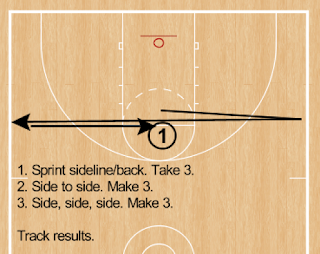Dorrance writes that he developed the concept as a modification of what UNC basketball great Dean Smith coached.
Brian McCormick has written about the competitive cauldron here and in his book The 21st Century Basketball Practice.
Fitness. Dorrance believes that both speed (he has recruited trackletes believe he can train soccer skills) and recovery after sprints are critical.
We can modify Dorrance's fitness testing (methods and frequency). He includes a variety of sprinting, change of direction speed tests, and the Cooper 12-minute run using a 400m track. For example, he says that about two-thirds of his players will complete 7 1/4 laps (2900m) in the 12 minutes alloted. That translates to 14,500m/hour (~ 9 mph).
The UNC women also include the "Illinois Agility Run" (see below)
and a variety of sprint tests...
In his book, Lee Rose included testing of eight by 220 yard runs (three groups - guards, forwards, centers) with groups going off every forty seconds (on a 440 yard track) with groups using the interim for recovery.
Individual skills. We can emphasize whatever game dimensions we want, realizing that tracking performance and competition adds pressure to the athletes.
Free throw shooting (above)...establish your rules.
Timed layups (e.g. from the three-point line or half-court).
Timed shooting contests.
Bulk shooting (Pitino 168)
Combination drills (e.g. dribbling, passing, shooting).
One-on-one from the perimeter (with constraints, e.g. two dribbles). Players compete with a set number of possessions (e.g. 5) and develop a ranking.
One-on-one in the post (with constraints)
One-on-two scoring.
It's easy to see the fruits and reality for Dorrance. If parents of a high school All-American complain about their Susie's playing time, Dorrance uses his cachet and competitive matrix to respond, "your daughter is 22 of 26 on our competitive rankings and stands below three walk-ons". Good luck with that.
We all decide what's possible and practical for our situations.






